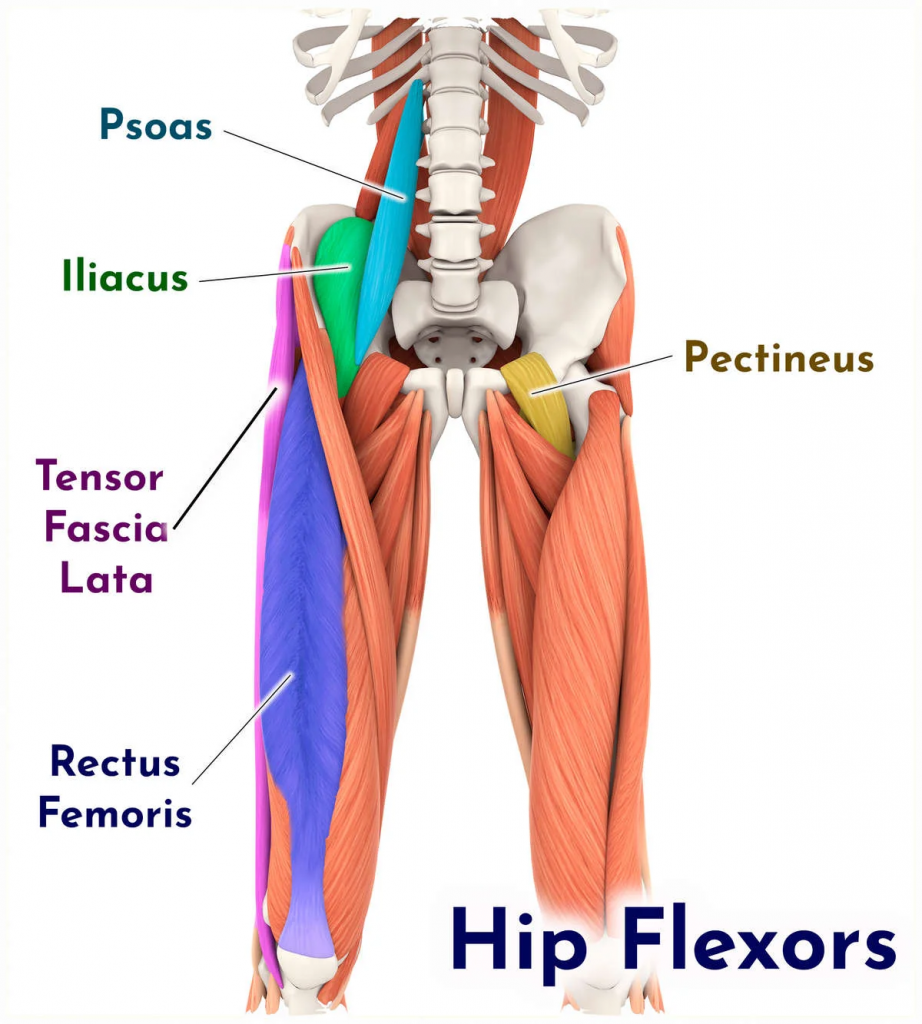The hip flexors are a group of muscles located at the front of the hip joint. These muscles play a crucial role in various movements, particularly in flexing or bending the hip joint. The primary hip flexor muscles include:
- Iliopsoas: The iliopsoas is actually a combination of two muscles: the psoas major and the iliacus. The psoas major originates from the lumbar spine and runs down through the pelvis, attaching to the femur. The iliacus originates from the iliac crest of the pelvis. Together, these muscles form a powerful hip flexor group.
- Rectus Femoris: The rectus femoris is one of the four muscles that make up the quadriceps muscle group at the front of the thigh. It crosses both the hip and knee joints, allowing it to contribute to both hip flexion and knee extension.
- Sartorius: The sartorius muscle is the longest muscle in the body. It runs obliquely across the front of the thigh and crosses the hip joint, assisting in hip flexion, as well as hip abduction and external rotation.
- Tensor Fasciae Latae (TFL): The TFL is a small muscle located at the side of the hip. While it primarily assists in hip abduction and internal rotation, it also contributes to hip flexion.
These muscles work together to flex the hip joint, bringing the thigh closer to the torso. They are engaged in activities such as walking, running, climbing stairs, and sitting down. Proper functioning and flexibility of the hip flexors are essential for maintaining good posture, balance, and overall lower body mobility.

Why are my hip flexors tight?
There can be several reasons why your hip flexors may be tight. Here are some common factors that contribute to tight hip flexors:
- Prolonged sitting: Sitting for extended periods, especially in a slouched or hunched position, can cause the hip flexor muscles to remain in a shortened position for an extended period. This can lead to muscle imbalances and tightness in the hip flexors.
- Lack of movement and physical activity: A sedentary lifestyle with minimal physical activity can contribute to tight hip flexors. Without regular movement and exercise, the hip flexor muscles may become weak and stiff.
- Muscle imbalances: Weakness or tightness in other muscles surrounding the hip, such as the glutes or hamstrings, can create muscle imbalances and increase stress on the hip flexors. This can cause them to tighten up as they compensate for the weakness or lack of support from other muscles.
- Overuse or repetitive movements: Engaging in activities that involve repetitive hip flexor movements, such as running or cycling, without proper stretching and strengthening exercises, can lead to tightness and strain in the hip flexor muscles.
- Injury or trauma: Previous injuries or trauma to the hip area can result in scar tissue formation and muscle tightness as part of the healing process.
- Stress and tension: Emotional and psychological stress can manifest physically in the body, leading to muscle tension and tightness, including in the hip flexor area.
It’s important to note that individual factors and circumstances can vary, and it may be helpful to consult with a healthcare professional or a physical therapist to determine the specific cause of your tight hip flexors and develop a personalized plan to address the issue effectively. They can assess your posture, movement patterns, and overall muscle balance to provide tailored recommendations and treatment options.
How do I fix my tight hip flexors?
Tight hip flexors can be problematic and lead to discomfort and limited range of motion. Fortunately, there are several effective strategies to help fix tight hip flexors. Here are some steps you can take:
- Stretch regularly: Incorporate regular stretching exercises into your routine to help lengthen and release tension in the hip flexor muscles. Perform stretches such as the standing hip flexor stretch, kneeling hip flexor stretch, or butterfly stretch mentioned earlier in this blog. Hold each stretch for 20-30 seconds and repeat a few times on each side.
- Strengthen the opposing muscles: Strengthening the muscles that oppose the hip flexors can help restore balance and alleviate tightness. Focus on exercises that target the glutes and hamstrings, such as bridges, squats, deadlifts, and hamstring curls. Strengthening these muscles can help relieve excessive strain on the hip flexors.
- Practice hip mobility exercises: Incorporate exercises that promote hip mobility to improve the flexibility and range of motion of your hip joints. Examples of such exercises include leg swings, hip circles, and dynamic lunges. These exercises help warm up and loosen the hip flexors, allowing for greater flexibility.
- Engage in hip flexor stretches throughout the day: Take breaks during prolonged periods of sitting or sedentary activities to perform hip flexor stretches. Stand up and stretch your hip flexors by doing a standing lunge or a kneeling hip flexor stretch. Making these stretches a habit can prevent the hip flexors from becoming excessively tight due to prolonged sitting.
- Consider foam rolling: Foam rolling can help release tension in the hip flexors and surrounding muscles. Lie face down on a foam roller and position it under your hip flexors. Roll slowly back and forth, targeting any tight or tender areas. Be sure to breathe deeply and relax as you roll. Foam rolling can be an effective method to relieve tightness and improve hip flexibility.
- Maintain proper posture: Poor posture can contribute to tight hip flexors. Focus on maintaining good posture throughout the day, whether you’re sitting, standing, or walking. Sit with your back straight and shoulders relaxed, and avoid crossing your legs for extended periods. Engage your core muscles to support your posture and prevent excessive strain on the hip flexors.
- Seek professional help if necessary: If you’ve tried various strategies and still experience persistent tightness or discomfort in your hip flexors, it may be beneficial to consult a healthcare professional or a physical therapist. They can assess your specific situation and provide personalized guidance and treatment options to address your tight hip flexors effectively.
Remember to listen to your body and proceed with caution when performing exercises or stretches. Gradually increase the intensity and duration of your workouts, and if you experience severe pain or discomfort, discontinue the exercise and consult a professional. With consistent effort and the right approach, you can successfully fix tight hip flexors and improve your overall hip flexibility and mobility.
